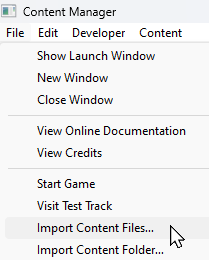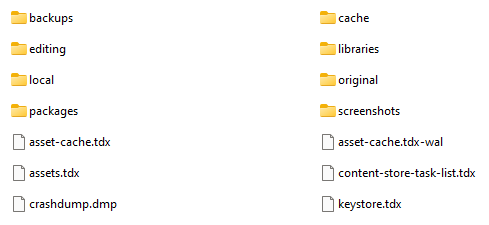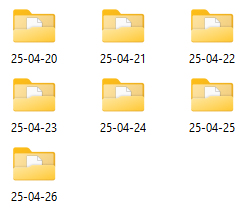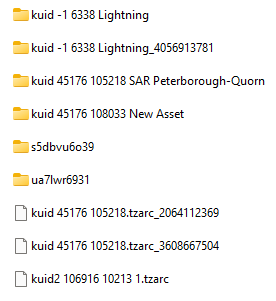How to Restore Deleted Assets
From TrainzOnline
(Difference between revisions)
m |
|||
| Line 421: | Line 421: | ||
</table> | </table> | ||
<br> | <br> | ||
| + | =='''Locate the Asset Backup Files'''== | ||
| − | + | <table width=1000 bgcolor="lightcyan" cellpadding=2> | |
| + | <tr valign="top"> | ||
| + | <td width=10>[[image:BlueDot10x10.png|link=]]</td> | ||
| + | <td>The backups of deleted assets are kept in folders identified by the date (during the last 7 days) when they were deleted</td> | ||
| + | </tr> | ||
| + | <tr valign="top"> | ||
| + | <td>[[image:BlueDot10x10.png|link=]]</td> | ||
| + | <td>The backups are stored as '''.tzarc''' files and will need a '''DBR''' to restore them</td> | ||
| + | </tr> | ||
| + | </table> | ||
| + | <br> | ||
| + | <table bgcolor=#000000 cellpadding=2> | ||
| + | <tr valign="top"> | ||
| + | <td> | ||
| + | <table bgcolor=#ffffb0 cellpadding=2> | ||
| + | <tr valign="top"> | ||
| + | <td width=25>[[image:NotePad.PNG|link=]]</td> | ||
| + | <td>If an asset was deleted more than 7 days ago then it cannot be restored by this method</td> | ||
| + | </tr> | ||
| + | </table> | ||
| + | </td> | ||
| + | </tr> | ||
| + | </table> | ||
| + | <br> | ||
| + | <table width=1000 bgcolor=#000000 cellpadding=2> | ||
| + | <tr valign="top"> | ||
| + | <td> | ||
| + | <table width=996 bgcolor=#ffffff cellpadding=2> | ||
| + | <tr valign="top"> | ||
| + | <td colspan=2><span style="font-weight: 700; font-size: 15px;">Steps:</span> To Restore Assets from their Backup Files:-</td> | ||
| + | </tr> | ||
| + | <tr valign="top"> | ||
| + | <td width=25>[[image:DotPoint1.JPG|link=]]</td> | ||
| + | <td>In '''File Explorer''' <span style="font-weight: 700; font-size: 15px; background-color: lightcyan;"> Double Left Click </span> on the '''Backups''' folder to open it up. Depending on how often you have used '''Surveyor''' during the last 7 days, and depending on your '''File Explorer''' display settings, you may see something like this... | ||
| + | <table> | ||
| + | <tr valign="top"> | ||
| + | <td width=246>[[image:UserDataDateBackupFolders.png|link=]]</td> | ||
| + | <td> | ||
| + | <table> | ||
| + | <tr valign="top"> | ||
| + | <td width=10>[[image:DotPoint.JPG|10px|link=]]</td> | ||
| + | <td>each folder is named using the date it was created (in '''yy-mm-dd''' display format)</td> | ||
| + | </tr> | ||
| + | <tr valign="top"> | ||
| + | <td>[[image:DotPoint.JPG|10px|link=]]</td> | ||
| + | <td>days where you did not use '''Surveyor''' will be missing folders</td> | ||
| + | </tr> | ||
| + | <tr valign="top"> | ||
| + | <td>[[image:DotPoint.JPG|10px|link=]]</td> | ||
| + | <td>only folders upto '''7 days ago''' will be present | ||
| + | </td> | ||
| + | </tr> | ||
| + | </table> | ||
| + | </td> | ||
| + | </tr> | ||
| + | </table> | ||
| + | </td> | ||
| + | </tr> | ||
| + | <tr valign="top"> | ||
| + | <td>[[image:DotPoint2.JPG|link=]]</td> | ||
| + | <td><span style="font-weight: 700; font-size: 15px; background-color: lightcyan;"> Double Left Click </span> on the folder for the day when the asset or assets were deleted. This will display all the backup files created that day. | ||
| + | <table> | ||
| + | <tr valign="top"> | ||
| + | <td width=276 rowspan=3>[[image:UserDataDateBackupFiles.png|link=]]</td> | ||
| + | <td width=10>[[image:DotPoint.JPG|10px|link=]]</td> | ||
| + | <td>Many, or nearly all, will be the '''automatic backup files''' created for the route and session that you were editing that day. These will have the same '''<kuid>''' ids in their folder and filenames as the route/session (e.g. the folder '''kuid 45176 105218 SAR Peterborough-Quorn''' snd the file '''kuid 45176 105218.tzarc_3680667504''' shown left). The files will have a sequence of numbers following the '''tzarc''' filetype</td> | ||
| + | </tr> | ||
| + | <tr valign="top"> | ||
| + | <!-- rowspan data --> | ||
| + | <td>[[image:DotPoint.JPG|10px|link=]]</td> | ||
| + | <td>Any assets that you opened for editing that day will also appear as backup folders. These will usually have the name, or part of the name, of the asset along with its '''<kuid>''' in the filename (e.g. '''kuid -1 6338 Lightning''' shown left)</td> | ||
| + | </tr> | ||
| + | <tr valign="top"> | ||
| + | <!-- rowspan data --> | ||
| + | <td>[[image:DotPoint.JPG|10px|link=]]</td> | ||
| + | <td>Assets that you have deleted will be shown using their '''<kuid>''' ids only as their filename (e.g. '''kuid2 106916 10213.tzarc''' shown left)</td> | ||
| + | </tr> | ||
| + | </table> | ||
| + | </td> | ||
| + | </tr> | ||
| + | </table> | ||
| + | </td> | ||
| + | </tr> | ||
| + | </table> | ||
| + | <br> | ||
| Line 460: | Line 545: | ||
<td> | <td> | ||
<span style="font-size: 17px;">'''Related Links'''</span><br> | <span style="font-size: 17px;">'''Related Links'''</span><br> | ||
| + | *'''[[How to Manage Backups|How to Manage Backups]]''' | ||
*'''[[How to Perform Database Repairs|How to Perform Database Repairs]]''' | *'''[[How to Perform Database Repairs|How to Perform Database Repairs]]''' | ||
| − | |||
*'''[[Understand_Content_Manager_Status_Labels|Understanding Content Manager Status Labels]]''' | *'''[[Understand_Content_Manager_Status_Labels|Understanding Content Manager Status Labels]]''' | ||
| + | *'''[[Using Content Manager to Update Assets|Using Content Manager to Update Assets]]''' | ||
</td> | </td> | ||
</tr> | </tr> | ||
Revision as of 20:57, 26 April 2025
| The information in this Wiki Page applies to TRS19, Trainz Plus and TRS22 and describes the methods that can be used to restore assets deleted by Content Manager. |
|
|
Restore Deleted DLS Assets |
| Deleted assets that were originally Installed from DLS can be easily restored by installing them again from the DLS |
| Deleted assets that were installed from the DLS are the easiest of all to restore. Simply use Content Manager to locate the assets and download them again. | ||
| Select the Download Station filter from the Filter drop down menu |  |
|
| Optional: Type part of the asset name in the Search box to narrow the search | ||
| Right Click on the asset name in the displayed list and select the Download option | ||
|
Restore Deleted .cdp File Assets |
| Deleted assets that were installed from .cdp files can be easily restored by reinstalling them from the same .cdp files |
 |
Deleted assets that were installed from .cdp files can be reinstalled from the same files.
|
||||||||||||||
Restore Deleted Payware and Packaged Assets |
| Payware and Packaged assets that were installed from a DLC package can be restored by reinstalling the same DLC Package | |
| If the identical Packaged asset is also on the DLS then it can be restored from there |
|
|
||||||||||||||
Restore Deleted Assets from the Backup |
| Assets deleted using Content Manager within the last 7 Days are stored in the Backup Folder for the date they were deleted | |
| Deleted assets are stored using their <kuid> code(s) and the date(s) they were deleted. Knowing this information is very helpful but is not vital |
|
Locate the Backups Folder
| The Backups folder where deleted assets are held is a subfolder of your Local User Data Folder |
|
||||||||||||||||||||||||||||||||||
Locate the Asset Backup Files
| The backups of deleted assets are kept in folders identified by the date (during the last 7 days) when they were deleted | |
| The backups are stored as .tzarc files and will need a DBR to restore them |
|
|
|||||||||||||||||||||
Trainz Wiki
|
|
This page was created by Trainz user pware in April 2025 and was last updated as shown below.








